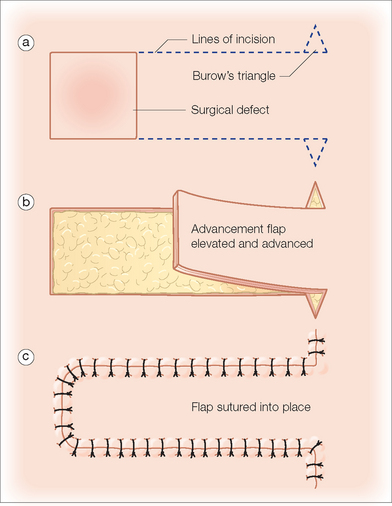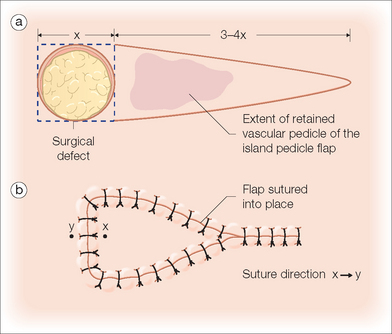Chapter 6 Island Pedicle Flaps
A majority of skin cancers are located on the face. Although there are many treatment options for non-melanoma skin cancers, the surgical treatment of cutaneous neoplasia remains the gold standard of care. Skin cancer continues to show increasing prevalence in the United States.1–3 It is important, therefore, that the dermatologic surgeon understand the various reconstructive options available for surgical defects. The majority of such wounds encountered by dermatologists are created during the extirpation of skin cancers, and these skin and soft tissue wounds of the face may present significant challenges to the physician. The reconstructive choices for any particular defect may vary considerably in technical difficulty, operative morbidity, and final result. The reconstructive option that preserves or restores anatomic function and provides pleasing final cosmesis will always prove superior.
Once the surgeon has successfully removed the skin cancer, efforts may then be directed to reconstruction. The potential for functional compromise must be carefully considered. If function has been preserved during tumor removal, it must be maintained during the surgical reconstruction. If function has been lost, it must be restored. The surgical defect is critically analyzed. The missing tissue is identified and characterized. The cosmetic units involved with the wound are defined. As previously described elsewhere, the face is subdivided into cosmetic subunits.4–8 Repairs, at times, may yield improved results when subunits are defined and repaired individually instead of relying upon a single flap or graft to repair a surgical defect that traverses more than one cosmetic subunit. The aesthetic limitations of second intention healing often restrict its use on the face. Although second intention healing has been shown to provide excellent postoperative results in certain areas of the face,9 the majority of surgical wounds on the face are better suited for surgical reconstruction. Whereas those areas with concave topography (the alar groove, inner canthus and concha, for example) typically yield good results with second intention healing, wounds in other areas such as the convex malar cheek or nasal dorsum show inferior results without appropriately performed operative repairs. The predictable postoperative contraction of granulating surgical wounds may present significant risk of anatomic distortion if the wound is close to the mobile eyelid margin, ala, or lip. Moreover, this postoperative contraction seen with second intention healing may fail to effectively restore contour. Such shadowed contour deformities typically provide poor cosmetic end results. For these reasons, only a small proportion of facial surgical wounds heal better with neglect than with reconstructive procedures.
FLAP DESIGN AND CONSIDERATIONS
Many variables must be considered when examining a surgical defect and considering reconstructive options. The effective restoration of soft tissue contours improves results by reducing the visual impact of the reconstructive scars. Closure options for soft tissue defects include primary closure (side-to-side repair), split- or full-thickness skin grafts, and local or distant skin flaps. For smaller and less complex defects in areas with adequate regional tissue laxity, primary closure may often be a suitable repair choice. To achieve good cosmetic results with primary closure, the surgeon must recognize the limitations of adjacent tissue reservoirs. The mobility of nearby facial structures and their tolerance for movement must be determined prior to initiating the surgical repair. Primary closure is principally used for smaller surgical defects of relatively low complexity. When the defect is too large to rely upon local tissue laxity to close the wound in a side-by-side fashion, a skin graft or flap may be considered. Both full- and split-thickness skin grafts may be used to repair cutaneous wounds in a wide variety of locations, and the uses of skin grafts are discussed elsewhere in this text. Although skin grafts, at times, may provide excellent final cosmetic results, they suffer from several limitations. To achieve excellence in cutaneous reconstruction, the surgeon must replace the missing tissue with tissue of identical or nearly identical character. When compared to the recipient site, the donor site’s skin should have a similar amount of sun damage, sebaceous glands, terminal hair, etc. Because skin grafts are usually harvested from sites not adjacent to the surgical defect, the harvested skin’s character is often dissimilar to that of the missing skin. Moreover, to ensure the survival of a full-thickness skin graft, all of the subcutaneous fat and portions of the dermis must be removed from the graft prior to its placement. The graft, therefore, may lack sufficient volume to adequately fill the surgical wound. For these reasons, flap repairs are best suited for many wounds on the face.
The flap repair of soft tissue defects is unsurpassed in its ability to provide functional preservation, contour restoration, and overall cosmetically appropriate reconstruction. A cutaneous flap is defined as a mobile attached unit of skin and soft tissue with its associated blood supply. Flaps are used extensively to repair a wide variety of soft tissue defects following skin cancer surgery in all anatomic locations. Flaps are widely used because they can often overcome many of the pitfalls seen with alternative repair options. Cutaneous flap surgery is safe10 and reproducible. Although cutaneous flaps may yield excellent results, flaps are not without the potential for some surgical risks and operative complications. It is important that the cutaneous surgeon have a firm knowledge of relevant anatomy, flap physiology, and flap design to maximize the opportunity for success. The nuances of proper surgical technique prove to significantly influence operative outcomes. Care must be extended to flap choice, flap design, incision and flap harvesting, and suture technique.
Cutaneous flaps are typically classified based upon one of two systems: either the type of principle movement (rotation, transposition, advancement, or interpolation) or blood supply (random or axial patterned).11 Because the majority of flaps performed by dermatologists are random pattern cutaneous flaps, skin flaps are more commonly classified on the basis of movement. Random pattern flaps of varied design are supplied by the richly anastomotic dermal vasculature, and they lack the axial pattern flaps’ larger caliber, named vessels in their bases. When the flaps are properly designed and executed, the abundant vascular supply of the dermis affords random patterned flaps optimum chances for survival.
The subcutaneous island pedicle flap (also called a V–Y advancement flap) is a random pattern cutaneous flap that is a useful method of repairing small to medium-sized facial wounds.12–28 The classical advancement flap recruits contiguous tissue to repair an adjacent defect by creating a flap elevated to its base after two parallel incisions are made (Figure 6.1). The traditional advancement flap, in this regard, is limited by the mechanics of the flap’s design. With the simple advancement flap, a length:width ratio of less than 3:1 must usually be followed to ensure the perfusion of the distal portion of the elevated flap. Advancement flaps designed with length:width ratios exceeding 3:1 or flaps inseted under significantly elevated wound closure tensions may be subject to inordinately high risks of distal ischemic necrosis. The IPF has surmounted this pitfall, which has, at times, limited the usefulness and success of the advancement flap. The IPF is designed so that a nutrient vascular pedicle closer to the flap’s leading edge is retained in order to provide an increased and more predictable vascular supply. The preserved central vascular pedicle significantly improves the perfusion of the flap’s anterior margin and eliminates the relative ischemia at the leading edge of the longer traditional advancement flap. Because it has an abundantly perfused central pedicle, the IPF can tolerate longer incisions and increased closure tensions than the classical advancement flap. The careful identification and preservation of a nutrient vascular pedicle in the IPF is therefore critical for the success of the flap. The classic design of the subcutaneous island pedicle flap is best used to repair defects of the upper cutaneous lip, anterior or mid-nasal ala, and brow (Figures 6.2–6.4).12,16,19,20,22,26 The flap may also be used to effectively repair defects of the nasal dorsum, cheek, forehead, or concha (the flip-flop flap).24,25,27,28 Modifications including a buried island pedicle flap and transposition island flap may expand the utility of the flap and may be used to repair defects of the medial canthus, lateral ala, and other sites.
In the classic design of the IPF (Figure 6.5), the preserved nutrient vascular pedicle is directly underneath the central portion of the mobile flap. Variations of the IPF with the vascular pedicle relocated to a lateral margin, a de-epithelealized distal flap, and a flap with bi-level muscular pedicles have been previously described.12,15,21,24,29 However, in the author’s opinion, none of these modifications can surpass the predictably reproducible results seen with the classic design of the island pedicle flap with a central vascular pedicle.












